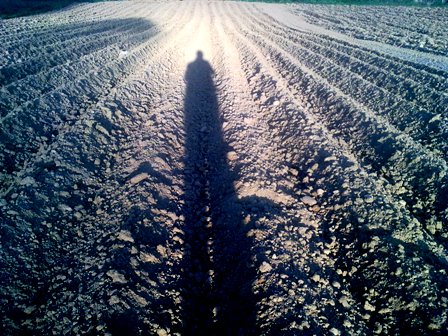
The female flowers of the hazel are sprouting their reddish tops.
The weather is sunny after some days of moderate rain.
The willows appear white with flowering catkins, the alder has grown its dark cones, blackthorns full bloomed, the joy of spring spreads everywhere and I, I... well, be it the weather, be it the trees, be it that I have to start a new job again, here I am too, giving my touch of colour to the landscape with the red-to-yellow of the exposed soil. My brush, a Howard rotavator. :-)
I work a small piece of land that has been previously plowed. Not the whole plot, just a small part of it, some rows to open the early season.
I need to calculate the minimum optimal area to be planted.
I am a machinist, a tractor driver. From my farmer point of view a row is the unit.
The planting machine is leveled and adjusted to plow rows 75 cm from one another. The widest machine to be used, a sprayer, covers 12 rows. The most effective use would be an even number of turns as the plot is entered and sorted by the same place and, well, I want to take advantage of that way back too! :-)
So 12 rows * 2 turns = 24 would be the most effective minimum number of rows to plant.
With the rotavator I smooth the soil so I have no reference of rows at all. I convert the length of rows to metres and stick a piece of a branch to mark the area. 24*0.75=18m. minimum effective width.
Two months ago I spent a whole Saturday morning converting the distance to different stars from light years to kms and then to earth years of distance at a velocity of 300 km/h. Not that I want to move that far away, I just wanted to exercise my brain for a while: the exponents became meaningless for practical comparisons (next time I'd try to calculate the total number of tubercles produced in the world, for instance), but at least I could better understand how different units are more operative than others!
The easiest way to calculate the area to be planted would be measuring the sprayer at its full width (9m) and then calculate the product 9m * 2 (number of turns) = 18m. That is, no need of counting rows at all!
Be it the power of experience, as it is by experience that the number or rows needed is known, be it an atavism or just a tractor driver way of thinking, at least for these plots there is a basic unit that appears to be graphic an intuitive without losing exactitude and transferability to SI units of length: the line, a row.
Now, as the hazel female flowers keep sprouting, the sun shines over a wet soil: good weather for the best results of potato plants per square metre, sure, and ... per row too! |
